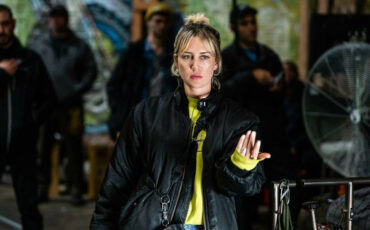
The “Lessons from Sundance” series will aim to capture kernels of wisdom from the producers, directors, cinematographers and panelists presenting here at Sundance. If you can’t be in Utah to enjoy the treasure trove of films, at least you can learn a little from the folks that got them there.
Amanda Kernell
Writer/Director of Sami Blood
Take away: “Tell the story the world hasn’t heard that only you can tell them.”
Universal themes are inevitable, but cookie-cutter plots are not. It is typical in a pitch deck to include a page with comparable films and what they grossed. This is not to say there is no merit in this. Of course, it is useful to approach investors with cinema case precedents, but this seems to have seeped into the gestation of story as well. Useful: “This film will have the same budget as Me, Earl, and the Dying Girl, appeal to the same demographic, and attempt to replicate the path to distribution. Harmful: Plot line Mad Libs. “It’s like the Titanic, but instead of a boat, it’s an RV, and instead of an iceberg, it’s a statue of FDR, and instead of the ocean it’s the molten center of the Earth. But the love story plays out the same.”
Rather than try and replicate someone else’s success, simply tell the story that only you can tell. Amanda Kernell educated the audience about Swedish racist and isolating actions against the Sami, a subject that few people in the room had ever even known existed. Half Sami herself, Kernell told the Sundance audience that in her parents generation, people still rarely identify Sami without prejudice or shame. Even in modern times, Sami children rarely speak Sami outside of their families, an an obstacle overcome for the actors in the film. In Sami Blood, she wanted to explore if a person can ever truly shed the skin they were born in. Can you really ever leave your past behind and become someone else?
Kernell did not want to cast anyone who did not speak Sami as their first language, because she believed it vital that the characters would be speaking what she calls a person’s “emotional language”. Even though this film is mostly a period piece, there is no distance between the two young actresses and their characters’ experiences in the finished piece. She even made sure the actresses had experience in herding reindeer, as an ease in the environment was essential in representing this dwindling population. The film achieves remarkable intimacy throughout, even in the widest landscape shots. This is a story you haven’t heard, and Kernell had to tell it. The result is a must-see film with a universal theme but a very specific vehicle.
Karim Amer
Oscar-nominated Director of The Square, and panelist for Illuminating Muslim Narratives.
Take away: “The ultimate test as a creator is to surround yourself with people of a certain community, and if you would be comfortable telling members of that community your story about them (you’ve passed).”
Fellow panelist and CEO of Chariot Entertainment reminds us that there are over 1.5 billion muslims worldwide, which is an enormous audience with little to no content being made for them. Most Muslim narratives highlight stereotypes and perpetuate a divide between Muslim communities and their neighbors. Amer stressed that the ISIS narrative has become the most resonant about Muslims for American audiences because we have failed to give them any other story about Muslim people and their real lives.
Director of Sundance’s New Frontier Labs, Kamal Sinclair says, “Storytelling is the code that identifies our cultural context… We need to deprogram that biased code”. She referenced this Harvard study in which Asian-Americans performed better on math tests when they were reminded of their ethnicity at the start of the test and performed worse when they were reminded of their gender. The researchers believe this is a result of the prevalent stereotypes that Asians are adept at math and women are not. The study reports that “implicit activation of a social identity can facilitate as well as impede performance on a quantitative task”. Where do filmmakers come into play? Well, this shows us that individuals of a larger social identity may become exactly who we portray them to be. You have a responsibility to bring those individuals out of the margins and represent who they actually are and who they can become.
“We don’t want sympathy; we want marketplace. This is a huge group of Americans who are hungry for stories about them”. He went on to express that he doesn’t think you have to be from a certain community to tell a story about that community. Amer encourages all filmmakers to assist in bringing these stories to the forefront. Just make sure that when you do, you cross every “t” and dot every “i” in your research. Luckily, the Muslim Public Affairs Council founded the MPAC Hollywood Bureau, which serves as a liaison between filmmakers and Muslims, and is eager and ready to help.
Zoe Lister-Jones
Director of Band-Aid.
Take away: “You can do WHATEVER you want, if you’re damn good at it.”
…Or rather: all-female crews make kickass films, and you should take notice. There are so many takeaways from Zoe Lister-Jones, but if you learn nothing else from the success of Band-Aid, it should be this.
A few times in my career, I’ve relayed to male colleagues that “someday I want to helm an all-female crew”. Every single time, I have been met with an uncomfortable smile and frequent nervous shrugging which adorably conveys they don’t want to be overtly sexist, but they definitely aren’t onboard with the thought of an all-female crew. A gaffer friend says, “Ya know, I know a few gals who have worked on all-female crews, and they just miss the balance. They don’t like it,” (COUGH ALTERNATE FACTS COUGH). Or a UPM friend says, “I don’t know, that just seems like you wouldn’t have both perspectives, and the guys in the cast would probably feel weird”. By the way, those same friends would never come off of an all-male crew and say, “Gosh, ya know, that just wasn’t very balanced, and I felt like I was missing a perspective.”
After the credits rolled on Band-Aid, 1200 audience members leapt to their feet and gave a standing ovation. Lister-Jones produced, wrote, directed, and starred in this movie, which also brings me back to her lesson. Often we believe what other industry professionals tell us is “the right way” to make a film, and then we just fall in line. “It’s just not done like that,” we say. When it comes to wearing many hats, filmmakers are often told they will come across as unprofessional narcissists. That’s only true if your head is too big for all of your hats (yeah, that pun’s intended). Lister-Jones knows what she is passionate about, knows what she can do, and then she goes and not only brings this remarkably modern tragicomedy to life, but brings a swarm of cinemaphiles to their feet doing it.
So if you’re a male, what can you take away from this? Firstly, hire more women. They need to be on your crews. If you need a reason, here: it’s 2017, and whether intentional or not, if you aren’t crewing your project with women, you are isolating 51 percent of your audience and robbing yourself and your crew of an equal opportunity work environment. Secondly, seek out films made by all-female crews, and no, they’re not just going to fall onto your lap. Luckily, Band-Aid is going to have huge distribution, so there will be at least one you can track down with little effort. Once you find such a film, examine everything. What have you been missing in telling the stories of female protagonists? How is this shot differently? How is this directed differently? Are performances different? As we said in this article, challenge yourself and find where you need to grow. Thirdly, learn this from Zoe: take what you are passionate about (such as seeing more women behind the camera) and infuse it into your filmmaking method. When that which drives you in life drives you in your creative process — even in the nuts and bolts of hiring or paperwork — that passion will infect your entire crew and it will undoubtedly come through in the final product.

























